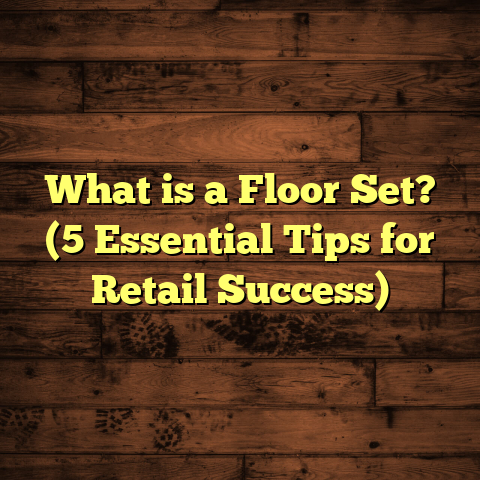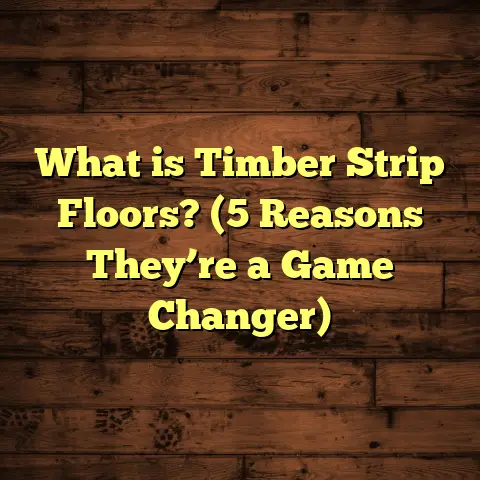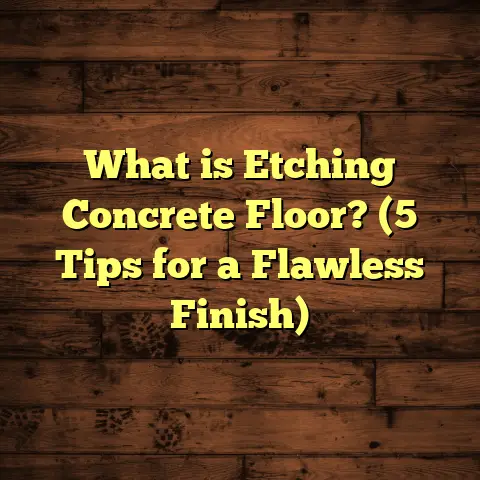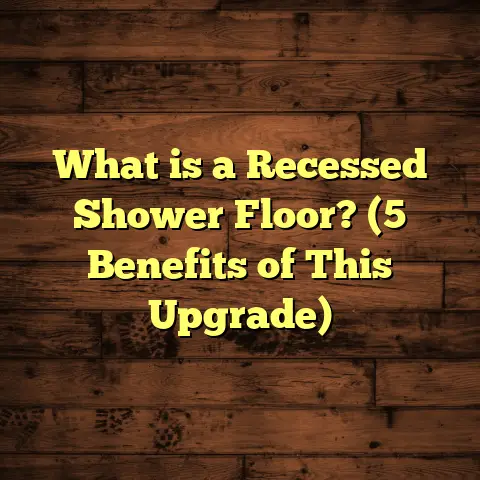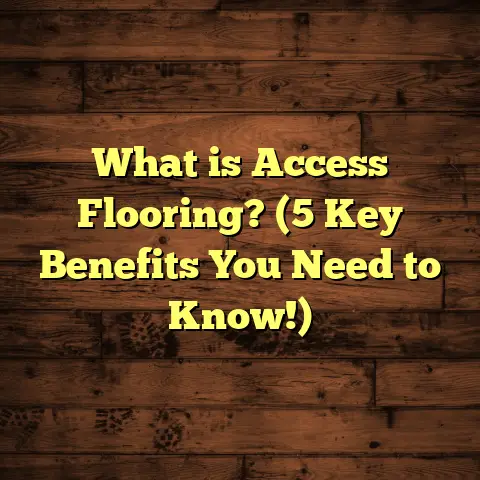What Is the Average Price for Installed Wood Floors? (5 Key Factors)
The creak beneath your feet, the rich aroma of freshly finished wood, and the warm glow that radiates from every plank—it’s hard not to feel something special when you walk into a room with wood floors. But then comes the question that always nags at the back of your mind: how much is this going to cost me once it’s all said and done?
What Is the Average Price for Installed Wood Floors?
When I say “average price for installed wood floors,” I’m talking about the total cost you’ll pay for having wood floors put in your home. Not just the price of the wood itself, but everything—the materials, labor, preparation, finishing, and sometimes even removal of old floors. This figure varies widely depending on several factors that can push the price up or down. Understanding these factors helps you plan your budget better and avoid sticker shock when the final invoice arrives.
The cost is usually expressed in dollars per square foot, which includes both materials and installation labor. So, if you hear someone say it costs $10 per square foot to install wood flooring, that means for every square foot of floor in your home, you’re paying $10 total for the wood plus the installation work.
But what exactly drives this price? Why do some people pay half as much as others for seemingly similar floors? I want to take you through everything I’ve learned after over a decade on countless projects—what affects pricing, what surprises may come up, and how you can make smart choices.
5 Key Factors That Affect Your Wood Floor Installation Cost
1. Type of Wood Flooring Material
Material choice is where most people start—and often get overwhelmed. There’s a huge range here—from affordable domestic hardwoods to rare exotic species that can cost a small fortune.
Solid hardwood is what most people picture when they imagine wood floors. These planks are made from a single piece of wood, usually ¾ inch thick. Because they are solid wood all the way through, they can be sanded and refinished many times over their lifespan—sometimes up to 10 or more times. This longevity is a major reason why solid hardwood floors command higher prices.
Engineered hardwood, on the other hand, consists of a thin layer of real wood glued to several layers of plywood underneath. It looks just like solid wood but is usually thinner and less expensive—both in material cost and installation labor. However, engineered hardwood can only be sanded and refinished a limited number of times, often once or twice.
Exotic hardwoods like Brazilian cherry (Jatoba), tigerwood, or teak are prized for their rich color and grain patterns but cost significantly more. These woods are harder and denser than common domestic species like oak or maple, which means installation requires more effort and special tools.
Reclaimed wood has grown massively popular recently for its rustic charm and eco-friendly appeal. But reclaimed wood costs more because each plank has to be carefully cleaned, de-nailed, sorted, and sometimes re-milled before installation.
Here’s a rough breakdown based on recent market data and my personal experience:
| Wood Type | Material Cost Per Sq.Ft. | Installed Cost Per Sq.Ft. |
|---|---|---|
| Solid Oak | $4 – $8 | $8 – $15 |
| Hickory | $5 – $9 | $9 – $16 |
| Maple | $4 – $7 | $8 – $14 |
| Engineered Hardwood | $3 – $6 | $6 – $12 |
| Exotic Woods | $7 – $15 | $12 – $20+ |
| Reclaimed Wood | $8 – $12 | $15 – $22 |
I remember one project where a client insisted on white oak because they wanted a classic look that could last decades. The material alone was around $7 per square foot. Once we added labor, staining, and finishing, their total came out to about $14 per square foot. It was a big investment but one they were happy with for years.
2. Installation Complexity and Labor Costs
Labor often surprises people because it can sometimes cost as much or more than the materials themselves. Installing wood floors isn’t just about placing boards side-by-side. It’s precision work that requires careful preparation, cutting, fitting around obstacles like staircases or cabinets, fastening, sanding, staining, and sealing.
The complexity of installation directly impacts labor costs. Straightforward installations in large rooms with few corners will be cheaper than jobs with:
- Irregular room shapes
- Multiple doorways or thresholds
- Staircases or landings
- Subfloor repairs or leveling required
- Removal of old flooring
I’ve worked on projects where the subfloor was uneven or water-damaged—this added several days of prep work before we could even lay the first plank. Those extra hours at prevailing labor rates added hundreds or thousands to the final bill.
Labor rates also vary greatly by region. In metro areas with high costs of living (think New York City or San Francisco), hourly rates might hit $75-$100 or more per hour for skilled installers. In rural or less expensive regions, rates can be half that.
Typical labor cost breakdown:
| Region Type | Labor Cost Per Sq.Ft. |
|---|---|
| Urban (high cost) | $5 – $8 |
| Suburban | $3 – $6 |
| Rural | $2 – $4 |
One particular job stands out: a colonial home with tight hallways and several rooms connected by small landings. The installer had to custom-cut hundreds of pieces to fit around door frames and vents. Labor ended up costing nearly double what it would in an open-layout home of similar size.
3. Room Size and Shape
You might assume bigger rooms automatically mean higher costs—but not necessarily on a per-square-foot basis.
Large open rooms are generally easier and faster to work in because installers can move freely without constant cutting or adjusting boards around corners. Smaller rooms with lots of closets, doorways, and odd angles take longer because each plank must be custom measured and cut.
In my experience:
- A 1,000 sq.ft. open floor might cost $10 per sq.ft.
- Three 300 sq.ft. rooms with many corners might average $13-$15 per sq.ft.
Why? Because every edge requires careful measuring and trimming to make sure there are no gaps or uneven edges.
Also, if your room has stairs or multiple levels requiring transition strips or special molding, expect costs to rise.
I once worked on a Victorian house where each room was small but packed with architectural details—arched doorways, built-in seating nooks, fireplaces—each adding complexity to installation.
4. Finishing Choices
Finishing adds both protection and style to your new floors but also adds cost.
Most wood floors aren’t finished until after installation unless you opt for prefinished planks (more on that later). After laying solid hardwoods, we typically sand the surface smooth then apply stain (if desired) followed by protective sealants such as polyurethane.
You can choose:
- Oil-based finishes: Extremely durable but emit strong odors during application.
- Water-based finishes: Lower odor and quicker drying but sometimes less durable.
- Natural oil finishes: Like tung oil or linseed oil; environmentally friendly but require more maintenance.
- Matte vs. gloss: Matte finishes hide scratches better; glossy finishes highlight the wood’s shine but show wear more quickly.
Each finishing coat requires drying time which adds labor hours and sometimes delays project completion.
Finishing costs generally run between $2 to $5 per square foot installed depending on product choice and number of coats applied.
5. Geographic Location and Market Demand
Your zip code plays a much bigger role than many realize.
In cities like San Francisco or New York City:
- Wood floor installation can easily top $15 per square foot.
- Skilled labor costs are higher due to demand.
- Material availability may be limited or more expensive due to shipping.
In smaller cities or rural areas:
- Installed prices often range from $7-$10 per square foot.
- More local suppliers keep material costs down.
- Less competition among contractors can impact pricing either way.
I’ve traveled for work enough to see these differences firsthand. A project in a small town in Kansas cost about half as much as an identical job in Chicago just because labor rates were lower and material suppliers closer by.
My Personal Stories From the Field
I’ve seen it all when it comes to flooring projects—from tiny apartments to sprawling estates—and every job taught me something new about pricing surprises.
Story 1: The Hidden Subfloor Nightmare
Once I was hired for what was supposed to be a straightforward solid oak floor installation in a mid-century ranch house. On day one, while removing old carpet and vinyl tiles, we discovered the subfloor was water-damaged from years of leaks under the kitchen sink area.
Fixing this involved replacing several plywood sheets before laying new flooring could begin. This unexpected prep work added almost three days’ worth of labor—and nearly doubled the project’s cost in that area.
Clients were shocked at first but appreciated my honesty about why costs changed mid-project. It reminded me how important it is to budget for contingencies when planning wood floor installs.
Story 2: Choosing Engineered Hardwood For a Basement
A couple wanted wood floors in their basement—a tricky spot since moisture levels tend to be higher underground.
Solid hardwood wasn’t an option here because it’s prone to warping with humidity changes. Instead, we installed engineered hardwood designed specifically for below-grade use with moisture barriers underneath.
While engineered hardwood materials were cheaper upfront ($4 per sq.ft.), installation required special adhesives and vapor barriers which increased labor costs.
The total came out at about $11 per square foot—but the couple loved how warm their basement felt compared to cold concrete or tile.
Story 3: Reclaimed Wood For Rustic Charm
One of my favorite projects involved installing reclaimed barnwood floors in a mountain cabin.
Material costs were high—over $10 per square foot—because every plank had unique knots and nail holes that needed careful cleaning and prepping.
Labor was even more intense since we had to install each board carefully to maintain its character without damaging fragile spots.
Their final price? About $22 per square foot installed—but it gave them a one-of-a-kind floor that perfectly fit their rustic aesthetic.
Comparing Wood Flooring With Other Popular Flooring Options
If you’re weighing your options against alternatives like laminate, vinyl plank, tile, or carpet, here’s how wood stacks up:
| Flooring Type | Avg Installed Cost (per sq.ft.) | Longevity | Maintenance | Visual Appeal |
|---|---|---|---|---|
| Solid Hardwood | $8 – $15 | 30+ years | Moderate (refinishing) | Classic & timeless |
| Engineered Hardwood | $6 – $12 | 15-20 years | Easier upkeep | Very similar look |
| Laminate | $3 – $8 | 10-15 years | Easy cleaning | Synthetic look |
| Vinyl Plank | $2 – $7 | 10-20 years | Very easy | Good variety |
| Tile | $5 – $15 | 25+ years | Easy cleaning | Wide styles |
| Carpet | $3 – $7 | 5-10 years | Needs regular cleaning | Cozy but less durable |
Wood floors usually carry higher upfront costs, but they bring durability and beauty that synthetic products struggle to match. Plus, wood adds value if you ever decide to sell your home—a key reason many homeowners invest despite higher initial prices.
Some Data You Should Know
Recent industry studies show:
- The average installed cost for solid hardwood flooring nationwide is about $11 per square foot.
- Labor accounts for roughly 40%-50% of total installation costs.
- Prefinished hardwood floors (wood finished at factory) can reduce onsite labor time by up to 30%, saving money overall.
- About 85% of homeowners who install real wood flooring report satisfaction with their investment due to aesthetics and home value increases.
- On average, homeowners spend an additional 10%-15% over initial budget due to unforeseen subfloor issues or prep work.
How To Keep Your Costs Under Control Without Sacrificing Quality
From my experience working on dozens of projects, here are some tips:
- Choose engineered hardwood if you want lower upfront costs but still want real wood look.
- Opt for prefinished planks if you want quicker installation with fewer onsite finishing headaches.
- Prepare your space well beforehand—clear furniture and remove old flooring yourself if possible to save labor time.
- Get at least three quotes from reputable installers who can explain their pricing clearly—don’t just go with the cheapest bid!
- Factor in a waste allowance—usually 5%-10% extra material—to cover cutting mistakes or damaged boards without last-minute orders.
- Consider timing your project during off-season months when contractors are less busy; sometimes you can negotiate better rates then.
Wrapping It Up With Some Perspective
Wood flooring isn’t just a surface—it’s an investment in your home’s comfort, style, and value that pays off over years (even decades). The true cost depends on many things: type of wood you choose, how complex your rooms are, finishing options, location factors—and even luck with hidden subfloor issues!
When I think back on all the floors I’ve installed over the years—from budget-friendly engineered options in suburban homes to high-end reclaimed woods in luxury cabins—I realize one thing: knowing what drives price helps you make choices that fit both your style dreams and financial reality.
If you’re debating between options like laminate or vinyl plank versus real wood floors, remember: wood offers unmatched warmth, resale value, and longevity—but at a price premium.
Ready to take your next step? Talk with trusted flooring pros who can guide you through local pricing based on your exact needs—and enjoy the process of creating a beautiful space underfoot that lasts a lifetime.
If you want me to add specific case studies with numbers from particular cities or include more technical info on installation techniques affecting cost, just let me know!
